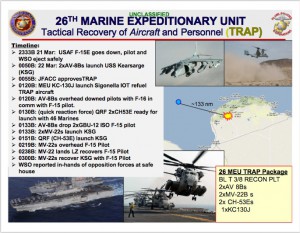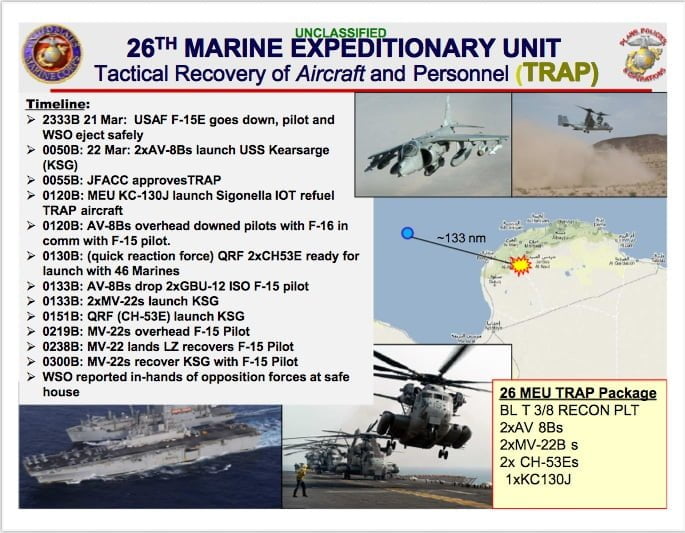08/17/2011 by Ed Timperlake
Ejecting out of a fireball from a two engine fire in my Navy jet below 500 feet at night showed me the difficulty of extracting a pilot surround by fire on the ground for a Search and Rescue Helo team. The weight of the seat pan in my unmanned back seat popped the chute and it went down in a clear open field. The fully loaded T-2B Buckeye’s exploding and burning jet fuel ignited a lot of trees and undergrowth consequently the visibility where I wound up was a huge problem.
The initial airborne issue for the rescue team was figuring out that the first chute they saw in the field was not mine. They thought it was my chute, and with no motion the call went out that the pilot was dead.
After shooting off survival pen flares and hoping for the best the helo finally found me having seen the reflective tape from my helmet. In lowering the rescue corpsman the pilot had considerable trouble with smoke and thermal currents trying to keep a solid hover and created a pendulum effect. Consequently the Corpsman had a rough journey down through the trees to see if I was ok.
Since I could walk, it was determined that the Corpsman could be hoisted back up but it would be safer if the helicopter’s spot light shined a path through the swamp to a road where I could be picked up. That plan worked and I thumbed a ride to the base in the back of a Shore Patrol van.
The point is even in a peaceful environment in CONUS search and rescue is very difficult and dangerous. That is why the interview with USMC Col Desens, Commander of 26th MEU describing how the USAF F-15E Strike Eagle crew call sign “Bolar 34” was rescued, is a critical case study for future con-ops.
https://sldinfo.com/the-impact-of-events-avoided-the-key-role-of-the-agile-response-group-arg/
As initial reporting shows, confusion on where the crew is physically located on the ground and in what condition is ever present in a Commander’s mind. The issue in a combat extraction is the constant need to factor in: what is the enemy capable of doing?
Accurate and timely Intel to all involved is critical. The enemy, especially our current adversaries, ruthless Islamic fanatics, capturing a POW in today’s world can alter events in remarkable ways.

As Admiral Locklear the DOD spokesman said-“One airman was picked up by nearby rebel soldiers and treated ‘with dignity and respect,’ including medical care, Locklear said. A military search-and-rescue team recovered the other airman.”
http://www.airforcetimes.com/news/2011/03/military-f15-crashes-in-libya-032211/
That military “search –and-rescue team” were the TRAP assets from the Navy/Marine team off the coast of Libya and saved not only the airman but also avoided a huge PR headache for the Obama Administration.
A combat coincidence is that USAF Viper Pilot Scott O’Grady “Basher Five-two,” after “E&E ing,” escaping and evading, for almost six days, was rescued by assets from the USMC 24th Marine Expeditionary Unit from the deck of the USS Kearsarge the same ship in the successful Libyan operation.
So now might be the time to sort out future combat Search and Rescue roles and missions. The USAF, as does the US Navy takes great pride in their promise to rescue downed aircrew. Unbelievable courage and skill has been evident in flying into danger by crews in hot LZs to save their fellow warriors.
From Korea, to Vietnam to current combat, aerial attack missions as needed will all be redirected to save the crew. Ground and Sea Special Forces can be tasked to go behind enemy lines to rescue crews. It is a promise made and if humanly possible at risk of death to the rescuers it is a promise kept.
Now is the time to revisit the entire Combat Search and Rescue mission and technology. On June 3 2009, Defense Industry Daily reported that the USAF and Secretary of Defense cancelled the CSAR-X competition. The twists, turns and one step short of “eye gouging” to win among Helicopter entry’s does not need to be repeated because now the MV-22 bridges both USMC and USAF SOC community.
Like the great architecture adage “form follows function” technology can drive the CSAR mission to create a perfect partnership opportunity for world wide CSAR shared by both US Air and Naval services.
http://www.defenseindustrydaily.com/gao-re-csarx-recompete-the-contract-03082/
In addition to the key building block, the MV-22 for time/distance both services USAF and USMC will have the F-35. It is now even more critical that as events in the Libyan TRAP mission proved with the reality of 10 minutes to feet dry from the ARG for AV-8s the F-35B can do that and also establish air superiority.
https://sldinfo.com/re-norming-the-navy-battle-fleet/
The Navy planners should think long and hard about any move to cancel the F-35B for the USMC. The Navy CBGs can have all the USN F-35Cs they wish to afford all well and good. But the Marine agility from the Sea changed the nature of the entire NATO Air War in Libya-why deny the next Commander in Chief the ability to rescue those who fall going into harms way.


